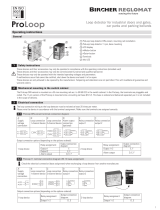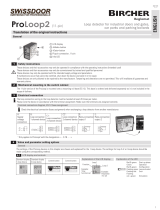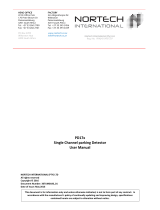Page is loading ...

1
ProLoop Lite 1.S
Loop detector for industrial doors and gates and car parks
Original instructions
General
1Safety instructions
3Electrical connection
2Mechanical mounting in the switch cabinet
ENGLISH
373635B
02/19
i
Info LED
LCD display
“Mode” key
“Data” key
Plug-in connection, 11-pin
Type plate
– These devices and their accessories may only be operated in accordance
with the operating instructions (intended use).
– These devices and their accessories may only be placed in operation by
trained and qualied personnel.
– These devices may only be operated with the operating voltages and
parameters intended for them.
– If malfunctions occur that cannot be eliminated, place the device out of
operation and send it in for repair.
– These devices may only be repaired by the manufacturer. Tampering and
alterations are not permitted. This will invalidate all guarantee and war-
ranty claims.
The 11-pin version of the ProLoop Lite is mounted onto a mounting rail base (ES 12). This base is ordered and delivered separately as it is not included
in the scope of delivery.
Check the electrical connection (base assignment) when exchanging a loop detector from another manufacturer.
The loop connection wiring to the loop detector must be twisted at least 20 times per meter.
Please wire the device in accordance with the terminal assignment. Make sure the terminals are assigned correctly.
A:
Supply voltage
connection
B:
Loop connection
D:
Relay connection
output 1
E:
Relay connection
output 2
AC
AC
A1 (2)
11 (1
)
32 (8)
24 (7)
1
(5) 22
A2
(6) 21
no
nc
common
(3) 14
31
(4) 12
no
nc
common
3.1 Terminal connection diagram, ES 12 base assignment

2
Mode
Data
Sim1
Sim2
Mode
Data
Sim1
Sim2
4.1 Value and parameter setting options
4.2 Basic functions of output relay status 0 (setting, see table 4.8)
4.3 Time functions 1, time unit 2 and time factor 3 (settings, see table 4.8)
4.4 Sensitivity 4 (setting, see table 4.8)
4.5 Automatic sensitivity boost ASB S (setting, see table 4.8)
4.6 Frequency 6 (setting, see table 4.8)
4.7 Switching from operating to conguration mode
Standard display
1-loop device
Control button Control button
1
Explanation of the LEDs
Info
Red + Green Start-up phase
conguration
Green Operation
Green ashing Output 1 or / and
2 activated
Flashing red Error
Explanation of the LCD display
Loop 1
Function
Example:
Time
function set
1
Example:
Parameter
“h” set
Parameter Loop unactivated Loop activated Fault
1Door and gate
2Barrier
3Quiescent
current
Activation of the
loop pulls the relay
on; the relay drops
off when the loop
is exited. t = typically ms or s
Switch-on delay:
When the loop is
activated, the relay is
pulled on after the time t
and drops off when the
loop is exited.
t
t = typically ms or s
Switch-o delay:
When the loop is
activated, the relay is
pulled on drops off after
time t t after the loop is
exited.
t
t = typically ms or s
Activation pulse:
When the loop is
activated, the relay
is pulled on and
drops back off
after time t.
t
t = typically ms or s
Exit pulse:
When the loop is exited,
the relay is pulled on and
drops back off after time
t.
t
t = typically ms or s
Maximum presence:
When the loop is
activated, the relay is
pulled on and drops back
off when exited, but not
later than after time t.
t
t = typically ms or s
The sensitivity S of the loop detector can be adjusted in 9 steps:
S1 = lowest sensitivity
(➝ much metal, low recognition distance)
S9 = highest sensitivity
(➝ little metal, large recognition distance)
S4 = factory setting
ASB (= Automatic Sensitivity Boost).
ASB is required in order to be able to detect trailer drawbars after activation.
Four different frequencies F1, F2, F3 and F4 can be set. This helps to prevent crosstalk with adjacent loops. Factory setting: F4.
1-loop device
Display after
start-up:
1Touch the «Mode» button
once to change to configura-
tion mode
Mode 1
(Back to automatic mode: Press and hold Mode button > 1 second)
Loop
Relay
Loop
Relay
Loop
Relay
Loop
Relay
Loop
Relay
Loop
Relay
4Value and parameter setting options

3
Table Settings Button
operation
parameter
Data
Data
Data
Data
Data
Data
Function LCD
Display
Button operation
functions
AOperating
mode
1
Mode
Operating mode 1
0Basic function 1
Mode
Door and gate* 1Barrier
1
Quiescent current 1
1Time function 1
Mode
∞* 1Switch-on delay
t
1
Switch-off delay
t
1Loop activation
pulse
t
1Loop exit pulse
t
1Maximum
presence
t
1
2Time unit
1
Mode
With time
function th (∞),
this display
does not appear
0.1 second 11 second*
1
1 minute 11 hour 1
Note:
Time unit multiplied by time factor
gives the set time.
3Time factor 1
Mode
With time
function th(∞),
this display
does not appear
1 * 1
Set value between 1 and 99 by touching or holding the «Data» button
4Sensitivity 1
Mode
S
Sensitivity =
responsiveness
4 * 1
Set value between 1 (lowest ) and 9 (highest sensitivity) by touching or holding the “Data” button
5Automatic
sensitivity
boost ASB
1
Mode
ASB stands for
Automatic
Sensitivity
Boost
Switched off* 1Switched on 1
6Frequency 1
Mode
Frequency F1
1
Frequency F2
1
Frequency F3 1Frequency F4* 1
*Factory setting
Loop
Relay
Loop
Relay
Loop
Relay
Loop
Relay
Loop
Relay
Loop
Relay
4.8 Conguration mode

4
Designed in Switzerland / Made in EU
BBC Bircher Smart Access, BBC Bircher AG, Wiesengasse 20, CH-8222 Beringen, www.bircher.com
5Error display
6Reset
7Technical data
8EC Declaration of Conformity
9WEEE
10 Contact
When an error occurs, the operating mode “A” and the error display “E” are shown alternatingly.
The LED changes to ashing red.
Mode
2 seconds Reset 1 (recalibration)
The loop(s) is/are recalibrated.
Power supply
voltage/
power consumption
24 VDC 24 VDC -10% to +20%,
84 mA, max. 1.3 W
230 VAC 230 VAC ± 10%, 50 Hz,
16 mA, max. 3.7 VA
Loop inductiveness Max. 20 to 1000 µH
Ideally 80 to 300 µH
Loop power line For 20-40 µH: max. 100 m with 1.5 mm2
For >40 µH max. 200 m with 1.5 mm2
Min. twisting 20 times per meter
Loop resistance < 8 ohms with connection wire
Output relay (loop) Max. 240 VAC; 2 A / 30 VDC; 1 A; AC-1
Dimensions 36 x 74 x 88 mm (W x H x D)
Housing mounting Mounting rail installation via 11-pin base ES12
Connection type Screw terminals base ES12
Protection class IP20
Operating
temperature
-20°C to +60°C
Storage
temperature
-40°C to +70°C
Air humidity < 95% non-condensing
See attachment
Devices with this symbol must be treated separately during disposal. This must be done in accordance with the laws of
the respective countries for environmentally sound disposal, processing and recycling of electrical and electronic equipment.
/


